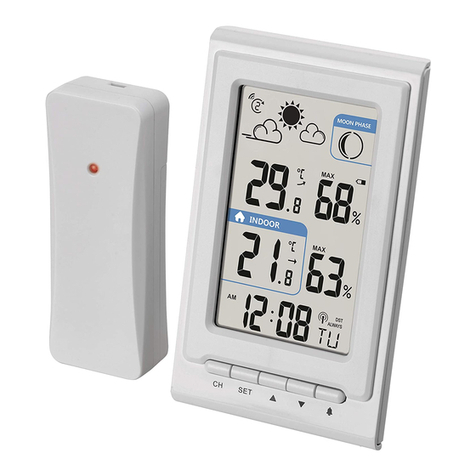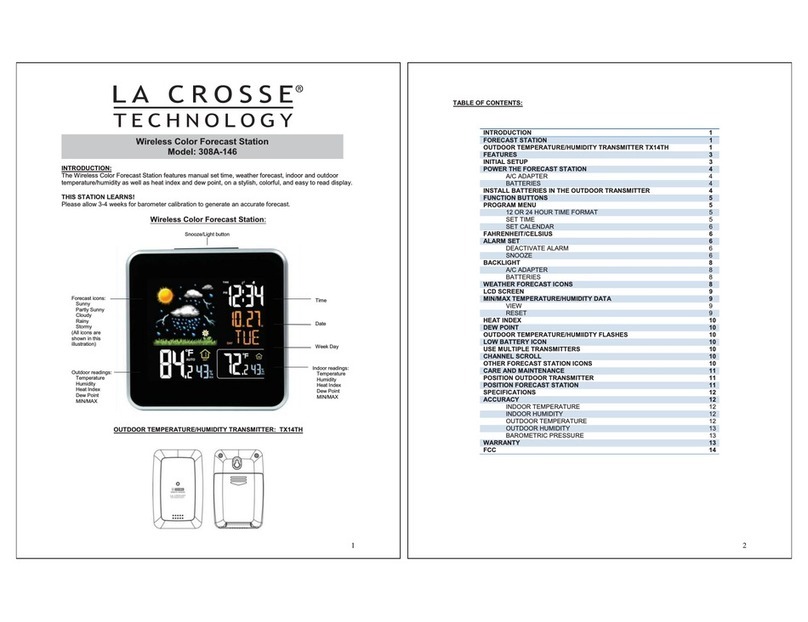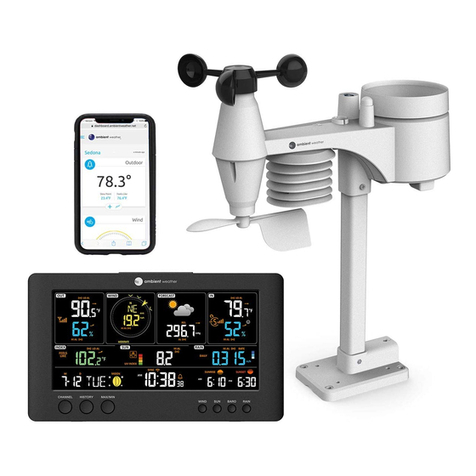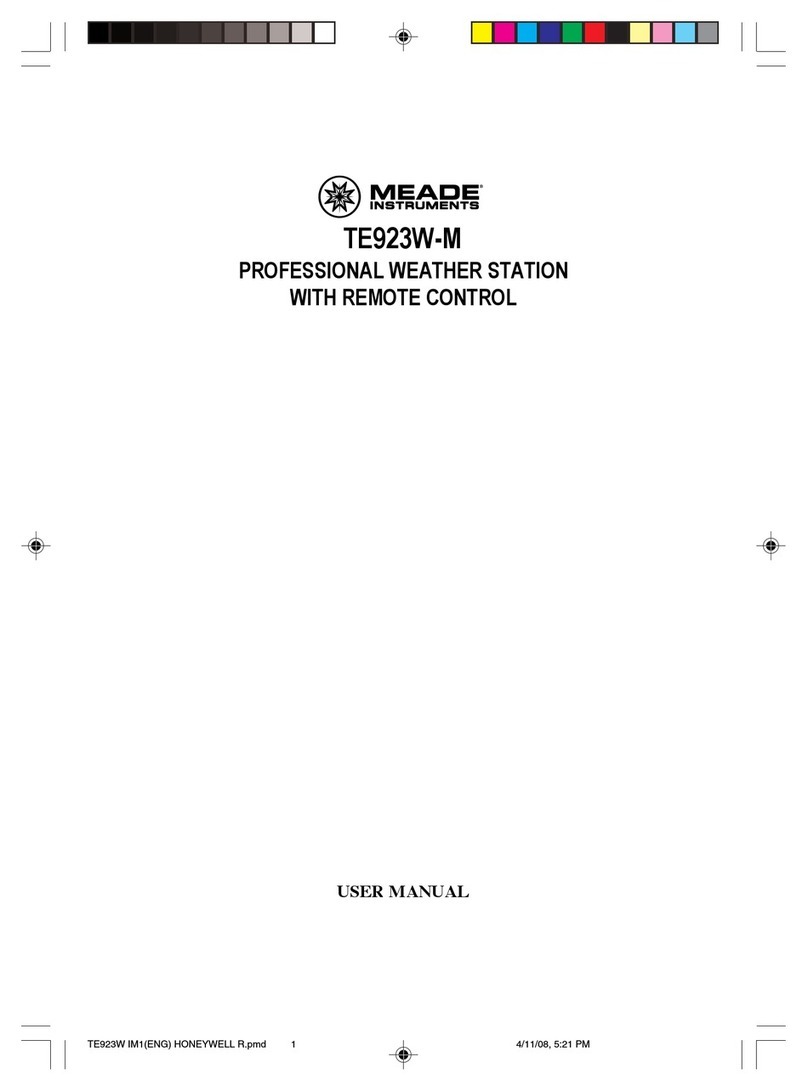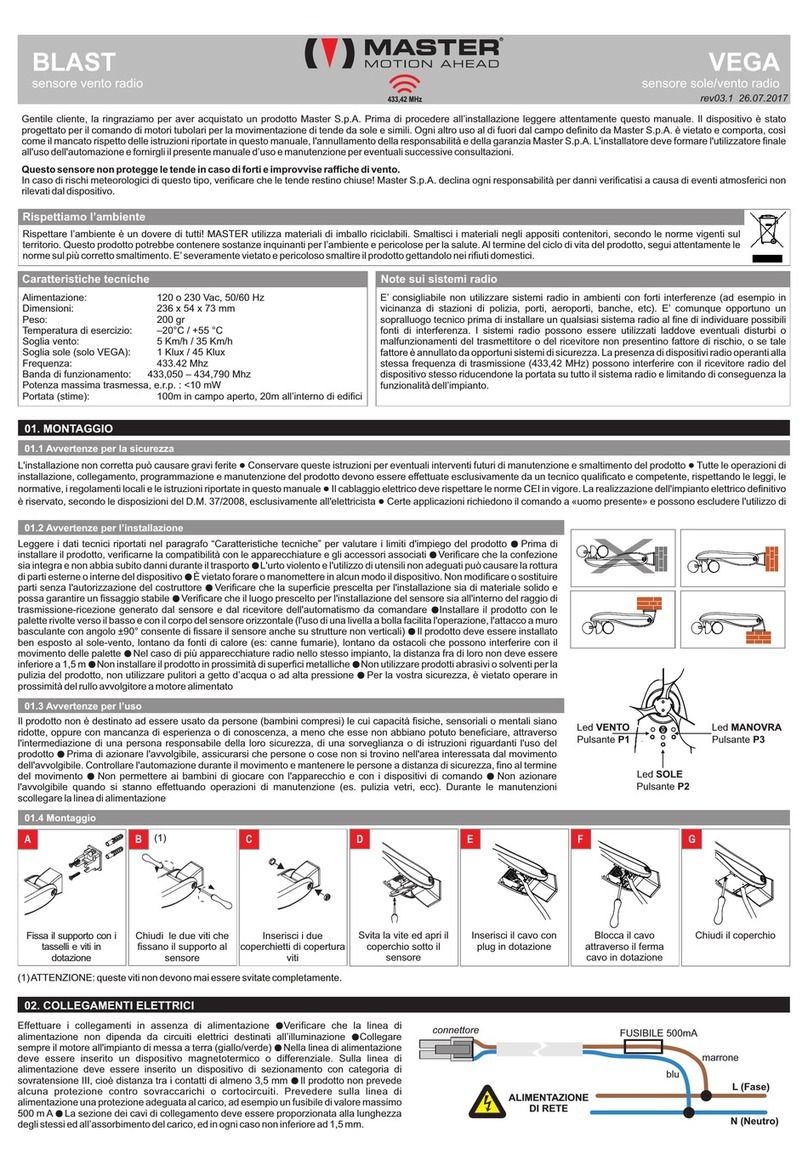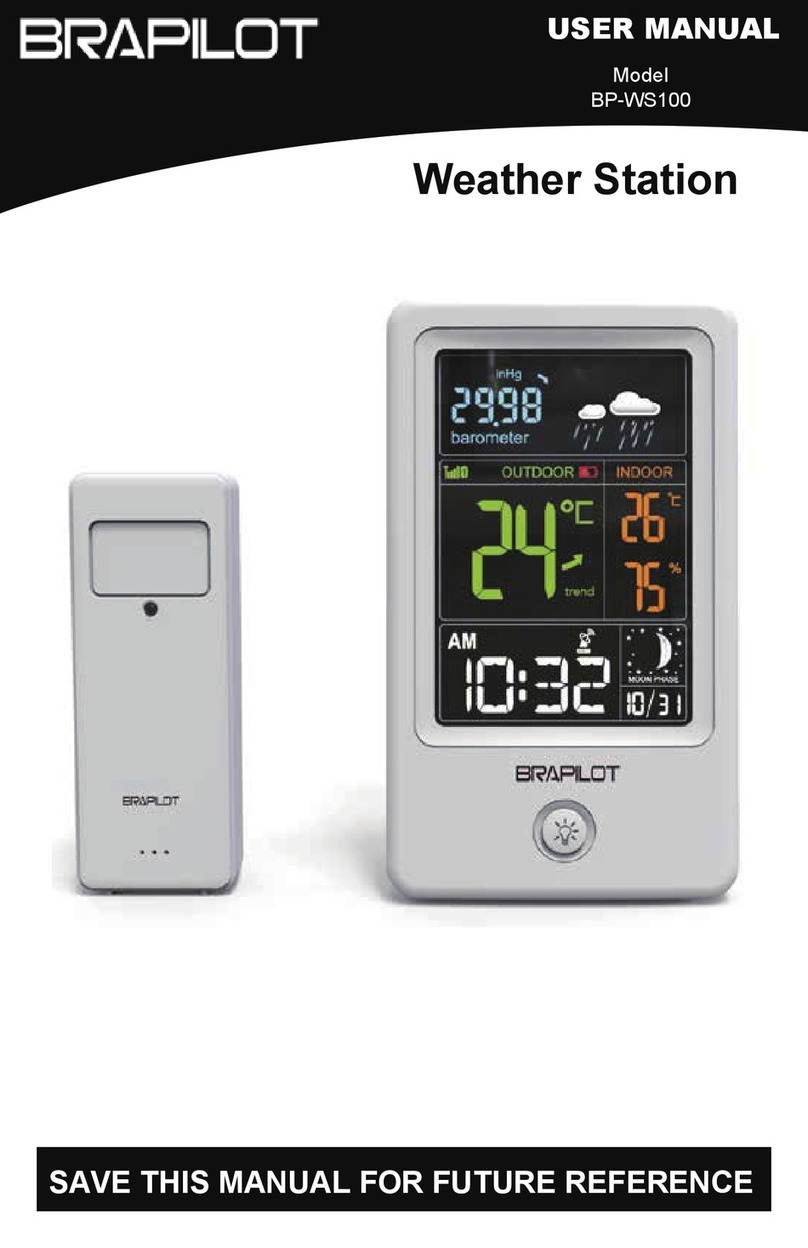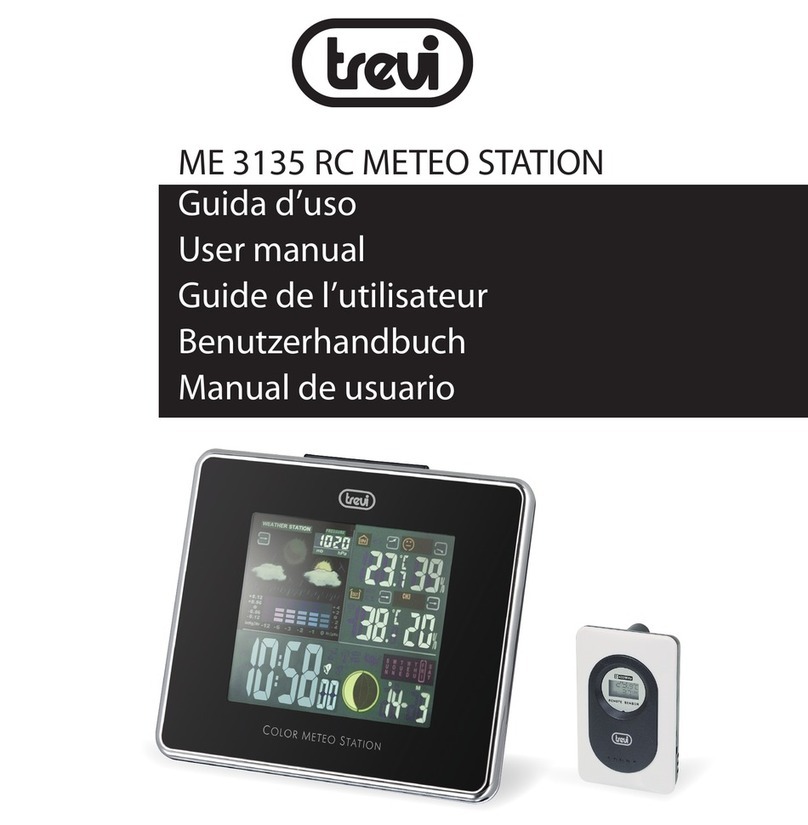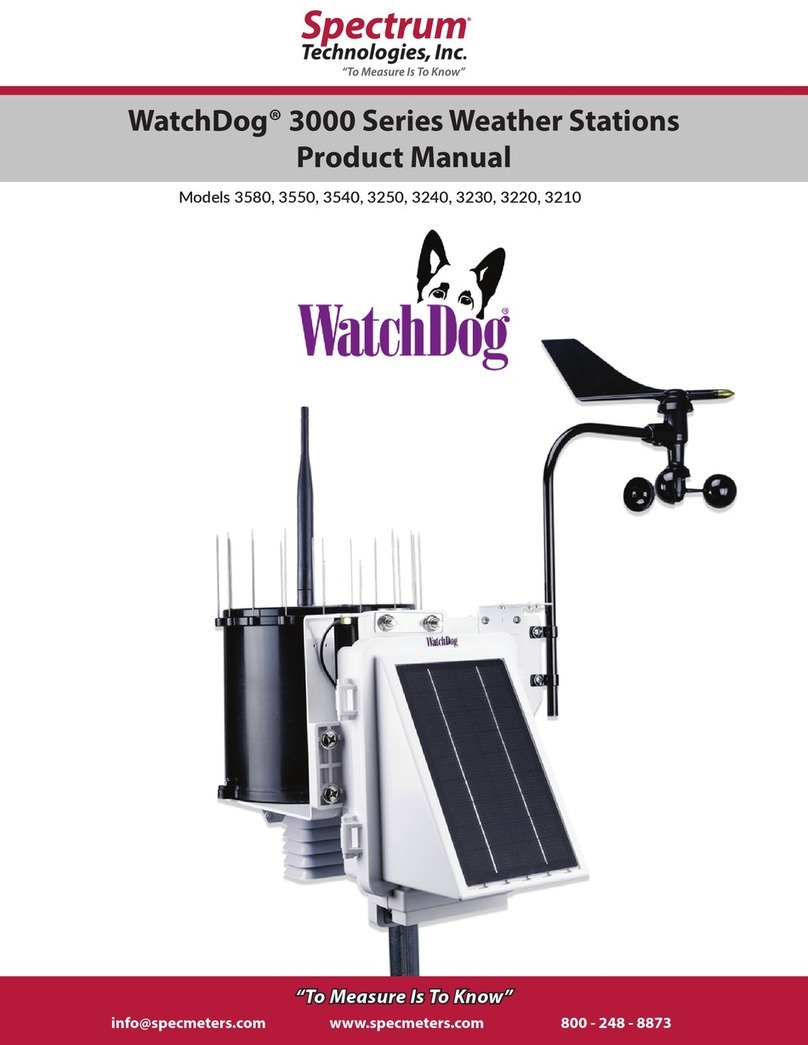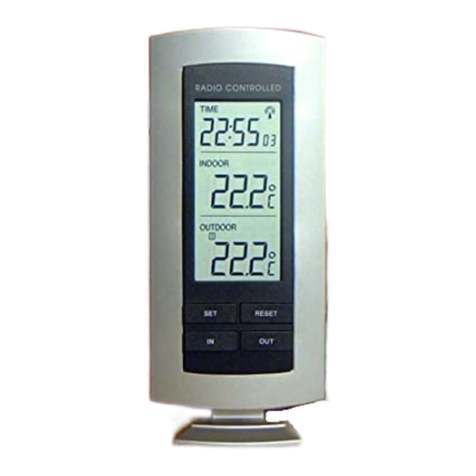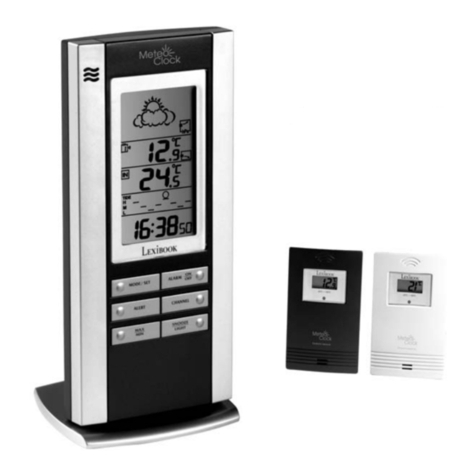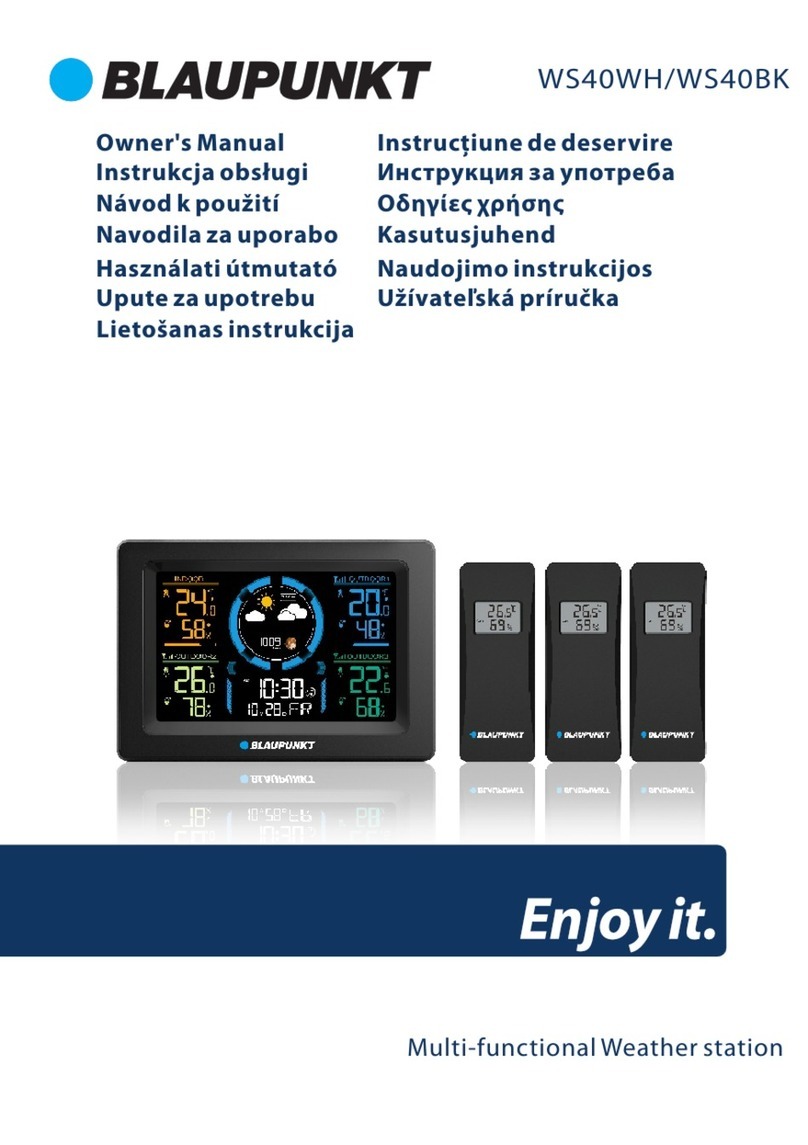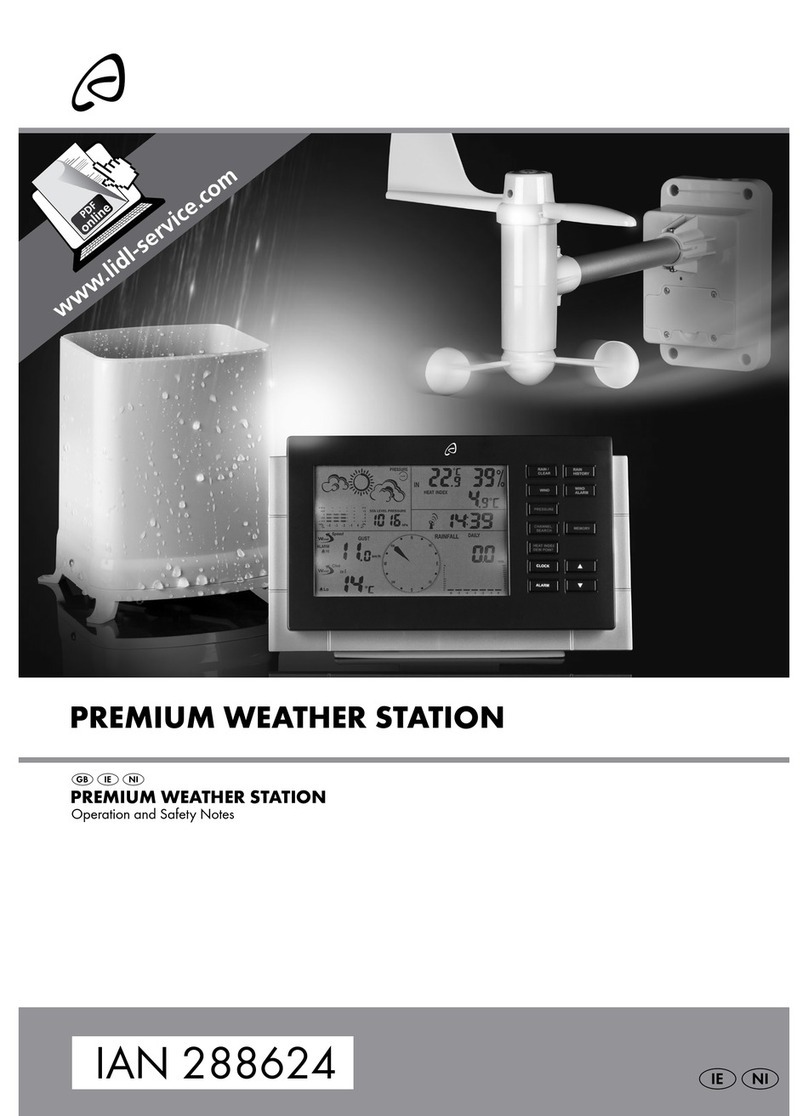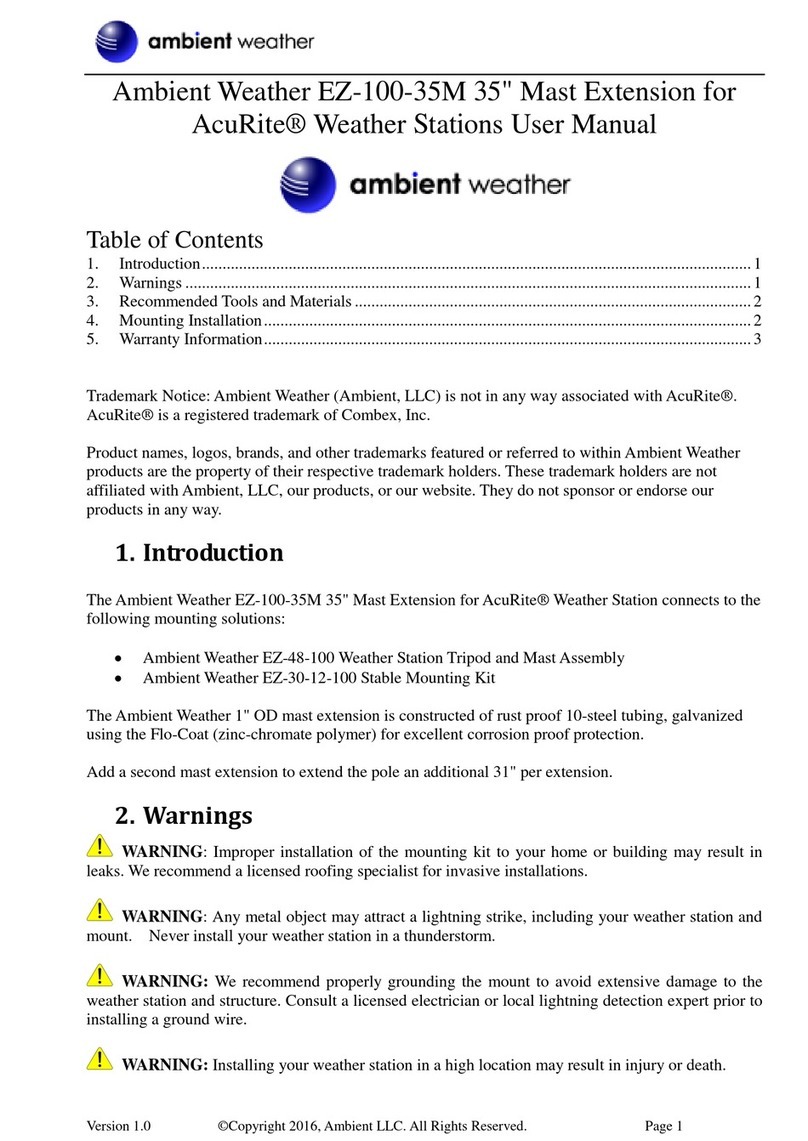Elsner Suntracer KNX sl Guide

Installation and Adjustment
EN
Suntracer KNX sl
Weather Station
Item number 70154
Elsner Elektronik GmbH Control and AutomationTechnology
Sohlengrund 16
75395 Ostelsheim Phone +49(0)7033/30945-0 info@elsner-elektronik.de
Germany Fax +49(0)7033/30945-20 www.elsner-elektronik.de
Technical support: +49 (0) 70 33 / 30 945-250

1 Contents
Elsner Elektronik GmbH • Sohlengrund 16 • 75395 Ostelsheim • Germany
Weather Station Suntracer KNX sl • from software version 1.00, ETS programme version 1.0
Status: 14.07.2016 • Errors excepted. Subject to technical changes.
1. Description ........................................................................................... 5
1.0.1. Deliverables ................................................................................................... 6
1.1. Technical specification ............................................................................................. 6
2. Installation and start-up ....................................................................... 7
2.1. Installation notes ...................................................................................................... 7
2.2. Installation location .................................................................................................. 8
2.3. Device design ......................................................................................................... 10
2.4. Installing the weather station ................................................................................ 10
2.4.1. Preparation for installation ........................................................................ 11
2.4.2. Fitting the lower part with mounting ........................................................ 11
2.4.3. Connection .................................................................................................. 13
2.4.4. Closing the installation ............................................................................... 14
2.5. Instructions for assembly and initial start-up ...................................................... 14
3. Addressing the equipment ................................................................. 15
4. Maintenance ....................................................................................... 15
5. Transfer protocol ............................................................................... 17
5.1. List of all communications objects ....................................................................... 17
6. Parameter setting .............................................................................. 57
6.0.1. Behaviour on power failure/power restoration ........................................ 57
6.0.2. Storage of threshold values ....................................................................... 57
6.0.3. Malfunction objects .................................................................................... 57
6.1. General settings ..................................................................................................... 57
6.1.1. GPS .............................................................................................................. 58
6.2. Location ................................................................................................................... 58
6.3. Rain .......................................................................................................................... 61
6.4. Temperature measurement value ........................................................................ 62
6.5. Temperature threshold values .............................................................................. 62
6.5.1. Temperature threshold value 1-4 .............................................................. 63
6.6. Frost alarm .............................................................................................................. 65
6.7. Brightness measurement value ............................................................................ 65
6.8. Brightness threshold values .................................................................................. 66
6.8.1. Brightness threshold value 1-4 .................................................................. 66
6.9. Twilight brightness threshold values ................................................................... 68
6.9.1. Twilight threshold value 1-4 ...................................................................... 68
6.10.Night ....................................................................................................................... 70
6.11.Sun position ........................................................................................................... 71
6.12.Wind measurement ............................................................................................... 71
6.13.Wind threshold values ........................................................................................... 72
6.13.1. Wind threshold value 1-4 ........................................................................... 73
6.14.Air pressure measurement ................................................................................... 75
6.15.Air pressure threshold values ............................................................................... 76
6.15.1. Air pressure threshold value 1-4 ............................................................... 76
6.16.Summer Compensation ........................................................................................ 78
6.17.Optimal usage of façade controller functions ..................................................... 79

2 Contents
Elsner Elektronik GmbH • Sohlengrund 16 • 75395 Ostelsheim • Germany
Weather Station Suntracer KNX sl • from software version 1.00, ETS programme version 1.0
Status: 14.07.2016 • Errors excepted. Subject to technical changes.
6.17.1. Classifying the façades for the control unit .............................................. 79
6.17.2. Orientation and inclination of the façade ................................................. 80
6.17.3. Shadow edge tracking and slat tracking ................................................... 81
6.17.4. Slat types and determination of width and spacing ................................ 82
6.17.5. Slat position for horizontal slats ................................................................ 83
6.17.6. Slat position for vertical slats .................................................................... 85
6.18.Simulation .............................................................................................................. 86
6.19.Status output .......................................................................................................... 87
6.20.Façade setting ........................................................................................................ 88
6.20.1. Façade safety ............................................................................................... 94
6.20.2. Façade automation ..................................................................................... 97
6.20.3. Computer ................................................................................................... 110
6.20.4. Computers 1-8 ........................................................................................... 110
6.21.Weekly timer ........................................................................................................ 113
6.21.1. Weekly timer period 1-24 ......................................................................... 114
6.22.Calendar timer ...................................................................................................... 115
6.22.1. Calendar clock Period 1-4 ......................................................................... 115
6.23.Logic ...................................................................................................................... 117
6.23.1. AND logic 1-8 and OR logic outputs 1-8 ................................................. 117
6.23.2. AND logic connection inputs ................................................................... 119
6.23.3. Connection inputs of the OR logic ........................................................... 122

3 Clarification of signs
This manual is amended periodically and will be brought into line with new software
releases. The change status (software version and date) can be found in the contents footer.
If you have a device with a later software version, please check
www.elsner-elektronik.de in the menu area "Service" to find out whether a more up-to-
date version of the manual is available.
Clarification of signs used in this manual
Installation, inspection, commissioning and troubleshooting of the device
must only be carried out by a competent electrician.
Safety advice.
Safety advice for working on electrical connections, components,
etc.
DANGER! ... indicates an immediately hazardous situation which will lead to
death or severe injuries if it is not avoided.
WARNING! ... indicates a potentially hazardous situation which may lead to
death or severe injuries if it is not avoided.
CAUTION! ... indicates a potentially hazardous situation which may lead to
trivial or minor injuries if it is not avoided.
ATTENTION! ... indicates a situation which may lead to damage to property if it is
not avoided.
ETS In the ETS tables, the parameter default settings are marked by
underlining.

4 Clarification of signs

5 Description
Weather Station Suntracer KNX sl • Status: 14.07.2016 • Errors excepted. Subject to technical changes.
1. Description
The Weather Station Suntracer KNX sl for the KNX building bus system measures
temperature, wind speed, brightness and air pressure. It recognises precipitation and
receives the GPS signal for time and location. In addition, using location coordinates
and the time, it calculates the exact position of the sun (azimuth and elevation).
All values can be used for the control of limit dependent switching outputs. States can
be linked via AND logic gates and OR logic gates. Multi-function modules change input
data as required by means of calculations, querying a condition, or converting the data
point type.
The integrated shade control system allows intelligent sun protection control of up to
8 façades.
The compact housing of the Suntracer KNX sl accommodates the sensors, evalua-
tion circuits and bus-coupling electronics.
Functions:
•Brightness measurement (current light strength)
•GPS receiver, outputting the current time and location coordinates. The
Weather Station Suntracer KNX sl also computes the position of the sun
(azimuth and elevation)
•Shade control for up to 8 façades with slat tracking and shadow edge tracking
•Wind measurement: The wind strength is measured electronically and thus
noiselessly and reliably, even during hail, snow and sub-zero temperatures.
Even turbulent air and rising winds in the vicinity of the device are recorded
•Precipitation detection: The sensor surface is heated, so that only drops and
flakes are recognised as precipitation, but not mist or dew. When the rain or
snow stops, the sensor is soon dry again and the precipitation warning ends
•Temperature measurement
• Frost protection for shading systems
•Air pressure measurement
•Weekly and calendar time switch: All time switching outputs can be used
as communication objects.
The weekly time switch has 24 periods. Each period can be configured either
as an output or as an input. If the period is an output, then the switching time
is set per parameter or per communication object.
The calendar time switch has 4 periods. Two on/off switching operations,
which are executed daily, can be set for each period
•Switching outputs for all measured and computed values. Threshold values
can be adjusted per parameter or via communication objects
•8 AND and 8 OR logic gates, each with 4 inputs. All switching events as well
as 16 logic inputs (in the form of communications objects) can be used as
inputs for the logic gates. The output of each gate can be configured optionally
as 1-bit or 2 x 8-bit
•8 multi-function modules (computers) for changing the input data by
calculations, by querying a condition or by converting the data point type

6 Description
Weather Station Suntracer KNX sl • Status: 14.07.2016 • Errors excepted. Subject to technical changes.
•Summer compensation for cooling systems. A characteristic curve matches
the target temperature in the room to the external temperature and sets the
minimum and maximum target temperature values.
Configuration is made using the KNX software ETS. The product file can be down-
loaded from the Elsner Elektronik website on www.elsner-elektronik.de in the “Ser-
vice” menu.
1.0.1. Deliverables
• Weather station
• Stainless steel installation band for pole installation
• 4×50 mm stainless steel roundhead screws and 6×30 mm dowels for wall
mounting. Use fixing materials that are suitable for the base!
1.1. Technical specification
Housing Plastic
Colour White / Translucent
Assembly Surface mount
Protection category IP 44
Dimensions approx. 62 × 71 × 145 (W × H × D, mm)
Weight approx. 85 g
Ambient temperature Operation -30…+50°C, storage -30…+70°C
Auxiliary supply 12…40 V DC, 12…28 V AC. An appropriate power sup-
ply unit can be purchased from Elsner Elektronik.
Auxiliary current at 12V DC: max. 185 mA
at 24V DC: max. 90 mA
at 24V AC: max. 82 mA
Bus current max. 10 mA
Data output KNX +/-
BCU type Integrated microcontroller
PEI type 0
Group addresses max. 2000
Assignments max. 2000
Communication objects 1387
Temperature sensor:
Measurement range -30°C … +50°C
Resolution 0.1°C
Accuracy ±0.5°C at -30°C … +25°C
±1.5°C at -30°C … +45°C
Wind sensor:
Measurement range 0 m/s … 35 m/s
Resolution 0.1 m/s

7 Installation and start-up
Weather Station Suntracer KNX sl • Status: 14.07.2016 • Errors excepted. Subject to technical changes.
The product conforms with the provisions of EU directives.
2. Installation and start-up
2.1. Installation notes
Installation, testing, operational start-up and troubleshooting should
only be performed by an electrician.
CAUTION!
Live voltage!
There are unprotected live components inside the device.
• National legal regulations are to be followed.
• Ensure that all lines to be assembled are free of voltage and take
precautions against accidental switching on.
• Do not use the device if it is damaged.
• Take the device or system out of service and secure it against
unintentional use, if it can be assumed, that risk-free operation is no
longer guaranteed.
The device is only to be used for its intended purpose. Any improper modification or
failure to follow the operating instructions voids any and all warranty and guarantee
claims.
After unpacking the device, check it immediately for possible mechanical damage. If it
has been damaged in transport, inform the supplier immediately.
Accuracy ±15% of the measurement value when incoming flow
is 45°…315°
(Frontal incoming flow corresponds to 180°)
Pressure sensor:
Measurement range 300 mbar … 1100 mbar
Resolution 0.1 mbar
Accuracy ±4 mbar
Brightness sensor:
Measurement range 0 lux … 150,000 lux
Resolution 1 lux at 0…255 lux
4 lux at 256…2,645 lux
163 lux at 2,646…128,256 lux
762 lux at 128,257…150,000 lux
Accuracy ±15% of the measurement value at 35 lux … 150,000
lux

8 Installation and start-up
Weather Station Suntracer KNX sl • Status: 14.07.2016 • Errors excepted. Subject to technical changes.
The device may only be used as a fixed-site installation; that means only when assem-
bled and after conclusion of all installation and operational start-up tasks and only in
the surroundings designated for it.
Elsner Elektronik is not liable for any changes in norms and standards which may occur
after publication of these operating instructions.
2.2. Installation location
Select an installation position on the building where the sensors can measure wind,
rain and sunshine without hindrance. No structural elements should be mounted
above the weather station, from which water could continue to drop on the precipita-
tion sensor even after it has stopped raining or snowing. The weather station should
not be shaded by structures or, for example, trees.
At least 60 cm of clearance must be left around the device. This facilitates correct wind
speed measurement without eddies. At the same time, this prevents spray (raindrops
hitting the device) or snow (snow penetration) from impairing the measurement. This
also prevents birds from biting it.
Please ensure that the extended awning does not cast shade on the unit, and that it is
protected from the wind.
Temperature measurements can also be distorted by external influences such as
warming or cooling of the building structure on which the sensor is mounted (sunlight,
heating or cold water pipes). Temperature variations from such sources of interference
must be corrected in the ETS in order to ensure the specified accuracy of the sensor
(temperature offset).
Magnetic fields, transmitters and interference fields from electrical consumers (e.g. flu-
orescent lamps, neon signs, switch mode power supplies etc.) can block or interfere
with the reception of the GPS signal.
Fig. 1
There must be at least 60 cm clearance to oth-
er elements (structures, construction parts,
etc.) below, to the sides and in front of the de-
vice.
60 cm

9 Installation and start-up
Weather Station Suntracer KNX sl • Status: 14.07.2016 • Errors excepted. Subject to technical changes.
Fig. 2
The device must be attached to a vertical wall
(or a pole).
wall
or
pole
90°
Fig. 3
The device must be mounted in the horizontal
(transverse) direction.
Horizontal
Fig. 4
For installation in the northern hemisphere,
the device must be aligned to face south.
For installation in the southern hemisphere,
the device must be aligned to face north.
North
South

10 Installation and start-up
Weather Station Suntracer KNX sl • Status: 14.07.2016 • Errors excepted. Subject to technical changes.
2.3. Device design
2.4. Installing the weather station
ATTENTION!
Even a few drops of water can damage the device electronics.
• Do not open the device if water (e.g. rain) can get into it.
1
Fig. 5
1 GPS receiver in lid
2 Programming LED
3 Brightness measurement
4 Precipitation sensor in lid
5 Temperature measurement
6 Wind measurement
7 Programming key on the underside of the housing (recessed),see Addressing the
equipment, page 15
8 Air pressure sensor in housing
ATTENTION!
Sensitive wind sensor.
• Remove the protective transport sticker after installation.
• Do not touch the sensor on the wind measuring element (no. 6).
5
6
8
23
4
7

11 Installation and start-up
Weather Station Suntracer KNX sl • Status: 14.07.2016 • Errors excepted. Subject to technical changes.
2.4.1. Preparation for installation
2.4.2. Fitting the lower part with mounting
Now, first of all, assemble the lower part of the housing with the integrated mounting
for wall or pole installation.
Wall installation
Use fixing materials (dowels, screws) that are suitable for the base.
Fig. 6
Slacken both screws on the lid (top) and low-
er part (bottom) with a Phillips screwdriver.
Fig. 7
Pull the lid and lower part completely apart.
This also releases the plug-in connection be-
tween the board in the lid and the socket in
the lower part.
Fig. 8
The device is installed with two screws. Break
off the two longitudinal holes in the lower
part of the housing.
Longitudinal holes

12 Installation and start-up
Weather Station Suntracer KNX sl • Status: 14.07.2016 • Errors excepted. Subject to technical changes.
Drilling plan
ATTENTION! The printout of the data sheet does not have original size! A separate, di-
mensionally correct drilling plan is included ex works and this can be used as a tem-
plate.
Fig. 9 a+b
a) If the power lead is to be hidden when in-
stalled, it must emerge from the wall in
the vicinity of the rear of the housing
(marked area).
b) If the power lead is to be surface-mount-
ed, the cable guide is broken off. The lead
is then fed into the device at the under-
side of the housing.
Cable guide
Fig. 10
Feed the power lead through the rubber gas-
ket.
Rubber
gasket

13 Installation and start-up
Weather Station Suntracer KNX sl • Status: 14.07.2016 • Errors excepted. Subject to technical changes.
Pole installation
The device is installed on the pole with the enclosed stainless steel mounting band.
2.4.3. Connection
The connector is in the lower part of the housing.
Fig. 11
Dimensions in mm. Variations are
possible for technical reasons
A/B2× longitudinal holes 8 mm ×
5.5 mm
C Position of the cable outlet (rub-
ber gasket) in the housing
AB
C
Fig. 12
Feed the mounting band through the eyelets
in the lower part of the housing.
Fig. 13
Break the cable guide off.
Feed the power lead through the rubber gas-
ket.
Cable guide
Rubber
gasket

14 Installation and start-up
Weather Station Suntracer KNX sl • Status: 14.07.2016 • Errors excepted. Subject to technical changes.
2.4.4. Closing the installation
2.5. Instructions for assembly and initial start-up
Remove all transport protection stickers present after installation.
The wind measurement value and thus also all wind switching outputs cannot be out-
put until 35 seconds after the power is turned on.
Fig. 14
Connect
KNX data (+|-) and
power supply (12…40V DC, 12…28V AC, 1|2)
to the connector.
The terminal assignment of the power supply
is polarity-independent.
-+12
-+12
KNX Voltage
Fig. 15
Push the lid on the lower part. This also
makes the plug-in connection between the
board in the lid and the socket in the lower
part.
Fig. 16
Screw the lid (top) and lower part (bottom) to-
gether.

15 Addressing the equipment
Weather Station Suntracer KNX sl • Status: 14.07.2016 • Errors excepted. Subject to technical changes.
After the auxiliary voltage has been applied, the device will enter an initialisation phase
lasting a few seconds. During this phase no information can be received or sent via the
bus.
3. Addressing the equipment
The equipment is delivered ex works with the bus address 15.15.250. You program a
different address in the ETS by overwriting the address 15.15.250 or teach the device
using the programming button.
The programming button can be reached through the opening on the underside of the
housing; it is recessed by approx. 15 mm. Use a thin object to reach the key, e. g. a
1.5 mm² wire.
4. Maintenance
WARNING!
Risk of injury caused by components moved automatically!
The automatic control can start system components and place people in
danger (e.g. moving windows/awnings if a rain/wind alarm has been
triggered while cleaning).
• Always isolate the device from the mains for servicing and cleaning.
1 2
Fig. 17
1 Programming button for teaching the device
2 Programming LED (under the semi-transparent lid)

16 Maintenance
Weather Station Suntracer KNX sl • Status: 14.07.2016 • Errors excepted. Subject to technical changes.
The device must regularly be checked for dirt twice a year and cleaned if necessary. In
case of severe dirt, the sensor may not work properly anymore.
ATTENTION
The device can be damaged if water penetrates the housing.
• Do not clean with high pressure cleaners or steam jets.

17 Transfer protocol
Weather Station Suntracer KNX sl • Version: 14.07.2016 • Technical changes and errors excepted.
5. Transfer protocol
Units:
Temperatures in degrees Celsius
Brightness in Lux
Wind in metres per second
Air pressure in Pascal
Azimuth and elevation in degrees
5.1. List of all communications objects
Abbreviation flags:
C Communication
R Read
WWrite
T Transmit
UUpdate
No. Text Function Flags DPT type Size
1 Software version Output R-CT [217.1] DPT_Version 2 bytes
21 Signal LED object 1s cycle Input -WC- [1.1] DPT_Switch 1 bit
22 Signal LED object 4s cycle Input -WC- [1.1] DPT_Switch 1 bit
24 GPS malfunction (0 : OK | 1: NOK) Output R-CT [1.2] DPT_Bool 1 bit
25 Date / time Output RWCT [19.1] DPT_DateTime 8 bytes
26 Date Output RWCT [11.1] DPT_Date 3 bytes
27 Time Output RWCT [10.1] DPT_TimeOfDay 3 bytes
28 Date and time query Input -WC- [1.017] DPT_Trigger 1 bit
30 Location: Northern latitude [°] Output R-CT [14.7] DPT_Value_An-
gleDeg
4 bytes
31 Location: Eastern longitude [°] Output R-CT [14.7] DPT_Value_An-
gleDeg
4 bytes
34 Rain: Switching output Output R-CT [1.1] DPT_Switch 1 bit
35 Rain: Switching output with fixed
delays
Output R-CT [1.1] DPT_Switch 1 bit
36 Rain: Switching delay to rain Input -WC- [7,005] DPT_TimePeri-
odSec
2 bytes
37 Rain: Switching delay to no rain Input -WC- [7,005] DPT_TimePeri-
odSec
2 bytes
41 Temperature sensor: Malfunction Output R-CT [1.1] DPT_Switch 1 bit
42 Temperature sensor: External meas-
urement
Input -WCT [9.1] DPT_Value_Temp 2 bytes
43 Temperature sensor: Measurement
value
Output R-CT [9.1] DPT_Value_Temp 2 bytes
44 Temperature sensor: Total measure-
ment
Output R-CT [9.1] DPT_Value_Temp 2 bytes
45 Temperature sensor: Min./Max. meas-
urement query
Input -WC- [1.017] DPT_Trigger 1 bit

18 Transfer protocol
Weather Station Suntracer KNX sl • Version: 14.07.2016 • Technical changes and errors excepted.
46 Temperature sensor: Minimum meas-
urement
Output R-CT [9.1] DPT_Value_Temp 2 bytes
47 Temperature sensor: Maximum meas-
urement
Output R-CT [9.1] DPT_Value_Temp 2 bytes
48 Temperature sensor: Min./Max. meas-
urement reset
Input -WC- [1.017] DPT_Trigger 1 bit
51 Temp. threshold value 1: Absolute
value
Input/
Output
RWCT [9.1] DPT_Value_Temp 2 bytes
52 Temp. threshold value 1: (1:+ | 0:-) Input -WC- [1.1] DPT_Switch 1 bit
53 Temp. threshold value 1: Switching
delay from 0 to 1
Input -WC- [7.5] DPT_TimePeriod-
Sec
2 bytes
54 Temp. threshold value 1: Switching
delay from 1 to 0
Input -WC- [7.5] DPT_TimePeriod-
Sec
2 bytes
55 Temp. threshold value 1: Switching
output
Output R-CT [1.1] DPT_Switch 1 bit
56 Temp. threshold value 1: Switching
output block
Input -WC- [1.1] DPT_Switch 1 bit
58 Temp. threshold value 2: Absolute
value
Input/
Output
RWCT [9.1] DPT_Value_Temp 2 bytes
59 Temp. threshold value 2: (1:+ | 0:-) Input -WC- [1.1] DPT_Switch 1 bit
60 Temp. threshold value 2: Switching
delay from 0 to 1
Input -WC- [7.5] DPT_TimePeriod-
Sec
2 bytes
61 Temp. threshold value 2: Switching
delay from 1 to 0
Input -WC- [7.5] DPT_TimePeriod-
Sec
2 bytes
62 Temp. threshold value 2: Switching
output
Output R-CT [1.1] DPT_Switch 1 bit
63 Temp. threshold value 2: Switching
output block
Input -WC- [1.1] DPT_Switch 1 bit
65 Temp. threshold value 3: Absolute
value
Input/
Output
RWCT [9.1] DPT_Value_Temp 2 bytes
66 Temp. threshold value 3: (1:+ | 0:-) Input -WC- [1.1] DPT_Switch 1 bit
67 Temp. threshold value 3: Switching
delay from 0 to 1
Input -WC- [7.5] DPT_TimePeriod-
Sec
2 bytes
68 Temp. threshold value 3: Switching
delay from 1 to 0
Input -WC- [7.5] DPT_TimePeriod-
Sec
2 bytes
69 Temp. threshold value 3: Switching
output
Output R-CT [1.1] DPT_Switch 1 bit
70 Temp. threshold value 3: Switching
output block
Input -WC- [1.1] DPT_Switch 1 bit
72 Temp. threshold value 4: Absolute
value
Input/
Output
RWCT [9.1] DPT_Value_Temp 2 bytes
73 Temp. threshold value 4: (1:+ | 0:-) Input -WC- [1.1] DPT_Switch 1 bit
74 Temp. threshold value 4: Switching
delay from 0 to 1
Input -WC- [7.5] DPT_TimePeriod-
Sec
2 bytes
75 Temp. threshold value 4: Switching
delay from 1 to 0
Input -WC- [7.5] DPT_TimePeriod-
Sec
2 bytes
76 Temp. threshold value 4: Switching
output
Output R-CT [1.1] DPT_Switch 1 bit
No. Text Function Flags DPT type Size

19 Transfer protocol
Weather Station Suntracer KNX sl • Version: 14.07.2016 • Technical changes and errors excepted.
77 Temp. threshold value 4: Switching
output block
Input -WC- [1.1] DPT_Switch 1 bit
81 Frost alarm Output R-CT [1.1] DPT_Switch 1 bit
95 Brightness sensor measurement Output R-CT [9.4] DPT_Value_Lux 2 bytes
96 Brightness sensor 2 measurement Output R-CT [9.4] DPT_Value_Lux 2 bytes
97 Brightness sensor 3 measurement Output R-CT [9.4] DPT_Value_Lux 2 bytes
98 Total brightness measurement Output R-CT [9.4] DPT_Value_Lux 2 bytes
101 Brightness sensor threshold value 1:
Absolute value
Input/
Output
RWCT [9.4] DPT_Value_Lux 2 bytes
102 Brightness sensor threshold value 1:
(1:+ | 0:-)
Input -WC- [1.1] DPT_Switch 1 bit
103 Brightness sensor threshold value 1:
Delay from 0 to 1
Input -WC- [7.5] DPT_TimePeriod-
Sec
2 bytes
104 Brightness sensor threshold value 1:
Delay from 1 to 0
Input -WC- [7.5] DPT_TimePeriod-
Sec
2 bytes
105 Brightness sensor threshold value 1:
Switching output
Output R-CT [1.1] DPT_Switch 1 bit
106 Brightness sensor threshold value 1:
Switching output block
Input -WC- [1.1] DPT_Switch 1 bit
108 Brightness sensor threshold value 2:
Absolute value
Input/
Output
RWCT [9.4] DPT_Value_Lux 2 bytes
109 Brightness sensor threshold value 2:
(1:+ | 0:-)
Input -WC- [1.1] DPT_Switch 1 bit
110 Brightness sensor threshold value 2:
Delay from 0 to 1
Input -WC- [7.5] DPT_TimePeriod-
Sec
2 bytes
111 Brightness sensor threshold value 2:
Delay from 1 to 0
Input -WC- [7.5] DPT_TimePeriod-
Sec
2 bytes
112 Brightness sensor threshold value 2:
Switching output
Output R-CT [1.1] DPT_Switch 1 bit
113 Brightness sensor threshold value 2:
Switching output block
Input -WC- [1.1] DPT_Switch 1 bit
115 Brightness sensor threshold value 3:
Absolute value
Input/
Output
RWCT [9.4] DPT_Value_Lux 2 bytes
116 Brightness sensor threshold value 3:
(1:+ | 0:-)
Input -WC- [1.1] DPT_Switch 1 bit
117 Brightness sensor threshold value 3:
Delay from 0 to 1
Input -WC- [7.5] DPT_TimePeriod-
Sec
2 bytes
118 Brightness sensor threshold value 3:
Delay from 1 to 0
Input -WC- [7.5] DPT_TimePeriod-
Sec
2 bytes
119 Brightness sensor threshold value 3:
Switching output
Output R-CT [1.1] DPT_Switch 1 bit
120 Brightness sensor threshold value 3:
Switching output block
Input -WC- [1.1] DPT_Switch 1 bit
122 Brightness sensor threshold value 4:
Absolute value
Input/
Output
RWCT [9.4] DPT_Value_Lux 2 bytes
123 Brightness sensor threshold value 4:
(1:+ | 0:-)
Input -WC- [1.1] DPT_Switch 1 bit
No. Text Function Flags DPT type Size
Other manuals for Suntracer KNX sl
1
Table of contents
Other Elsner Weather Station manuals
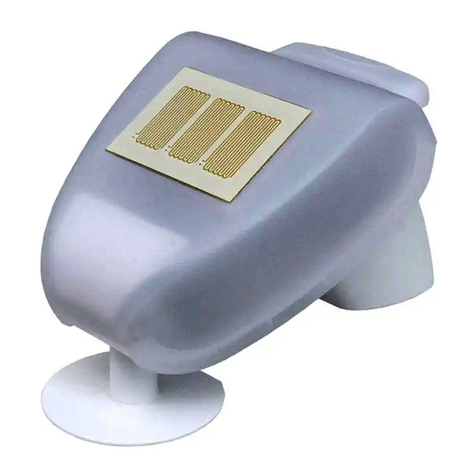
Elsner
Elsner P03 3 User manual
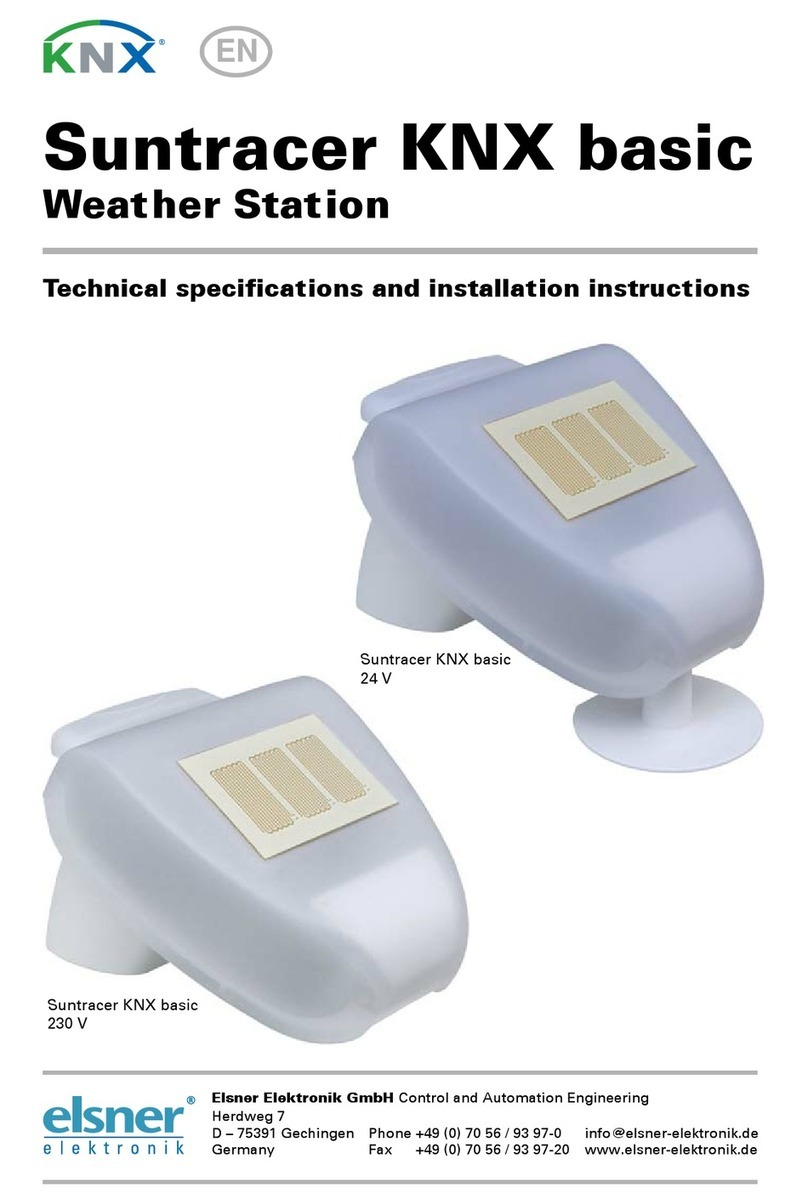
Elsner
Elsner Suntracer KNX basic Series User manual

Elsner
Elsner P03/3 User manual
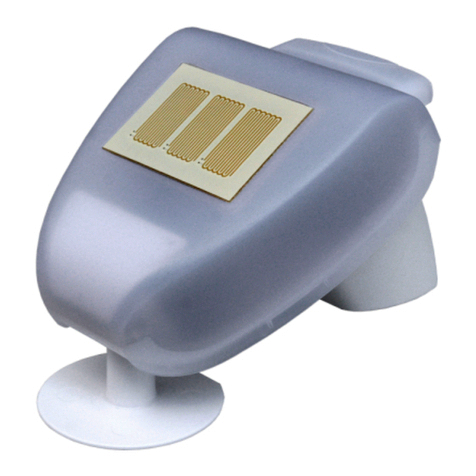
Elsner
Elsner Suntracer KNX basic Guide
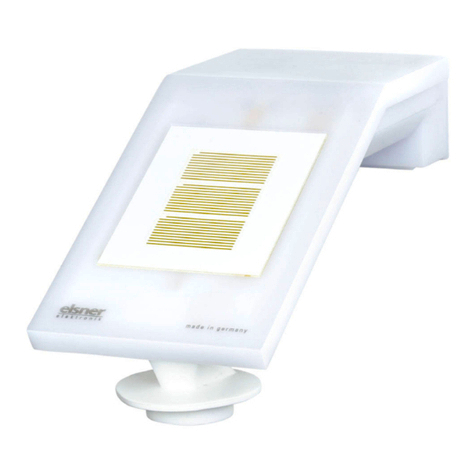
Elsner
Elsner Suntracer KNX sl Guide
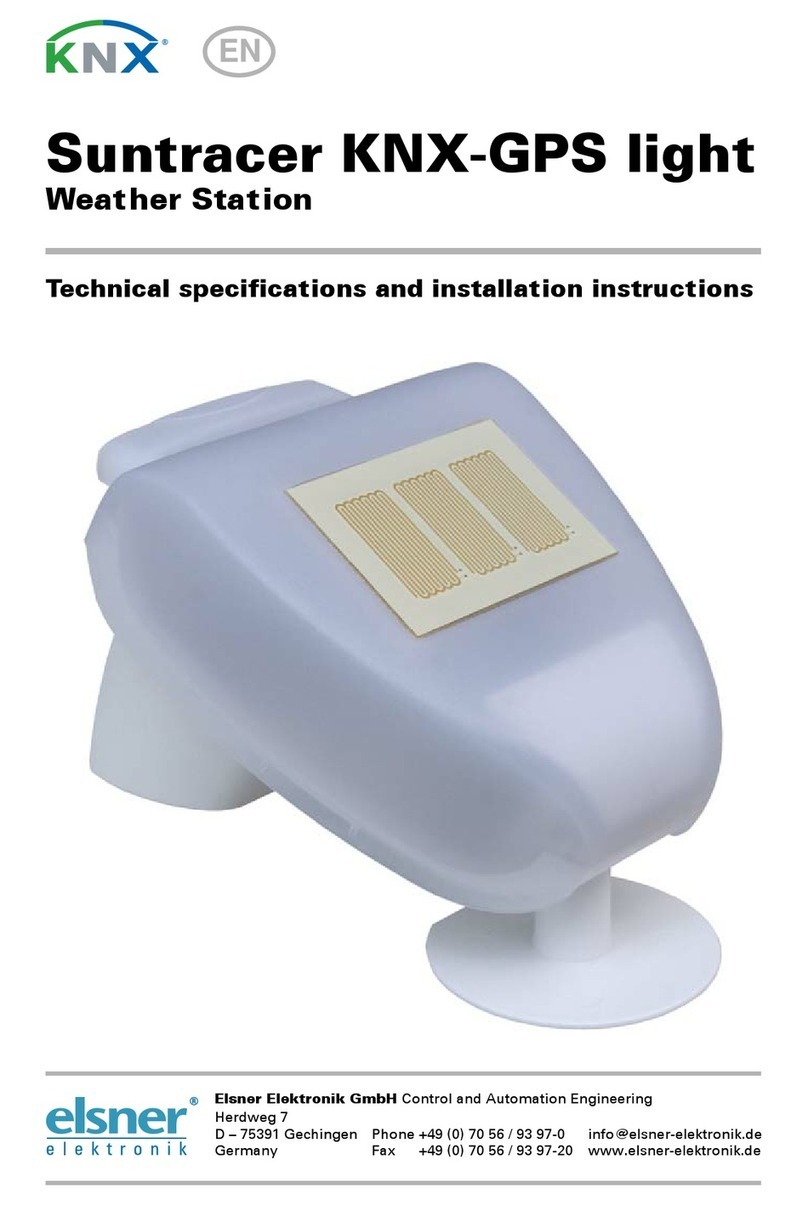
Elsner
Elsner Suntracer KNX-GPS User manual
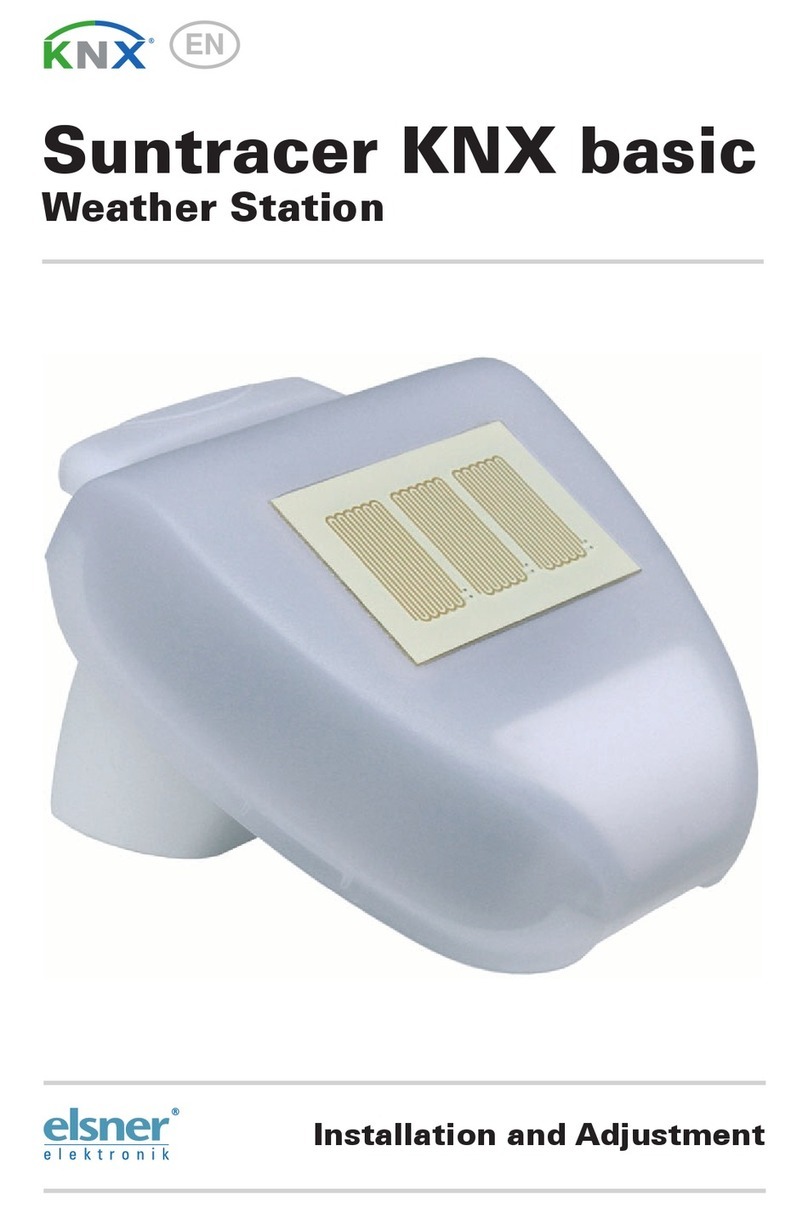
Elsner
Elsner Suntracer KNX basic Guide
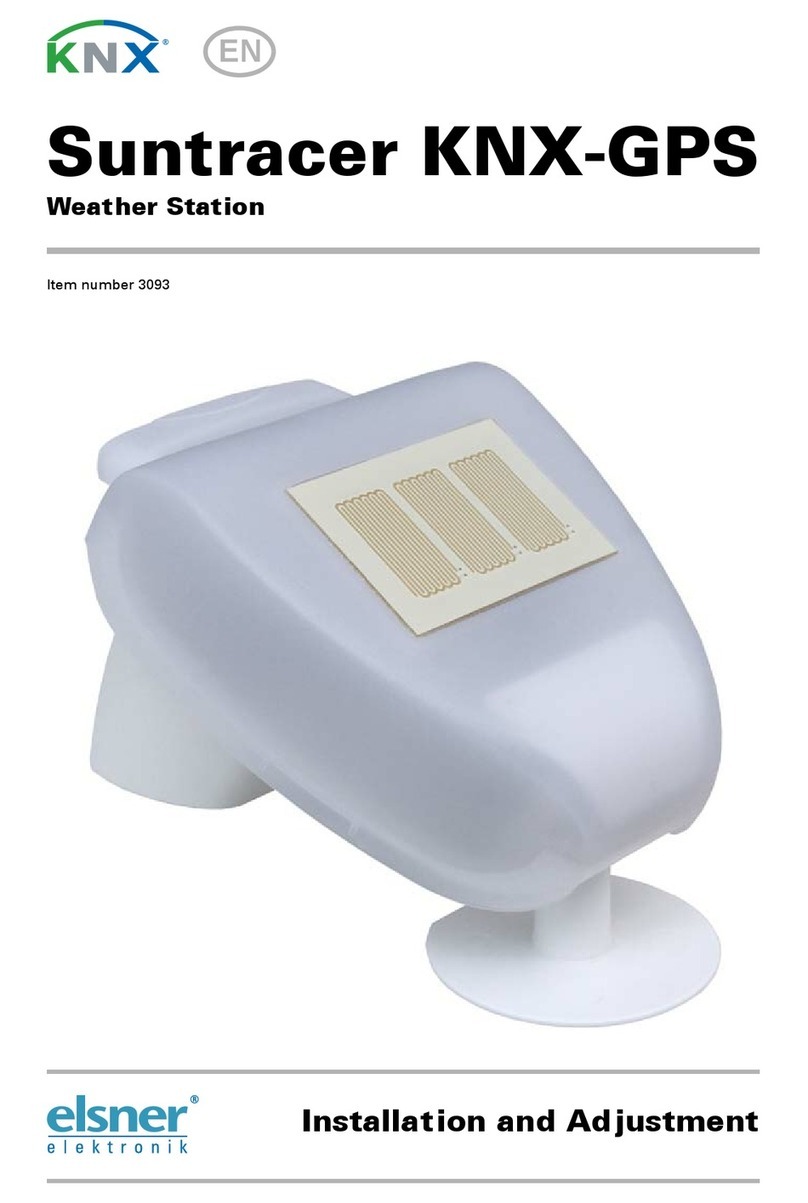
Elsner
Elsner Suntracer KNX-GPS Guide
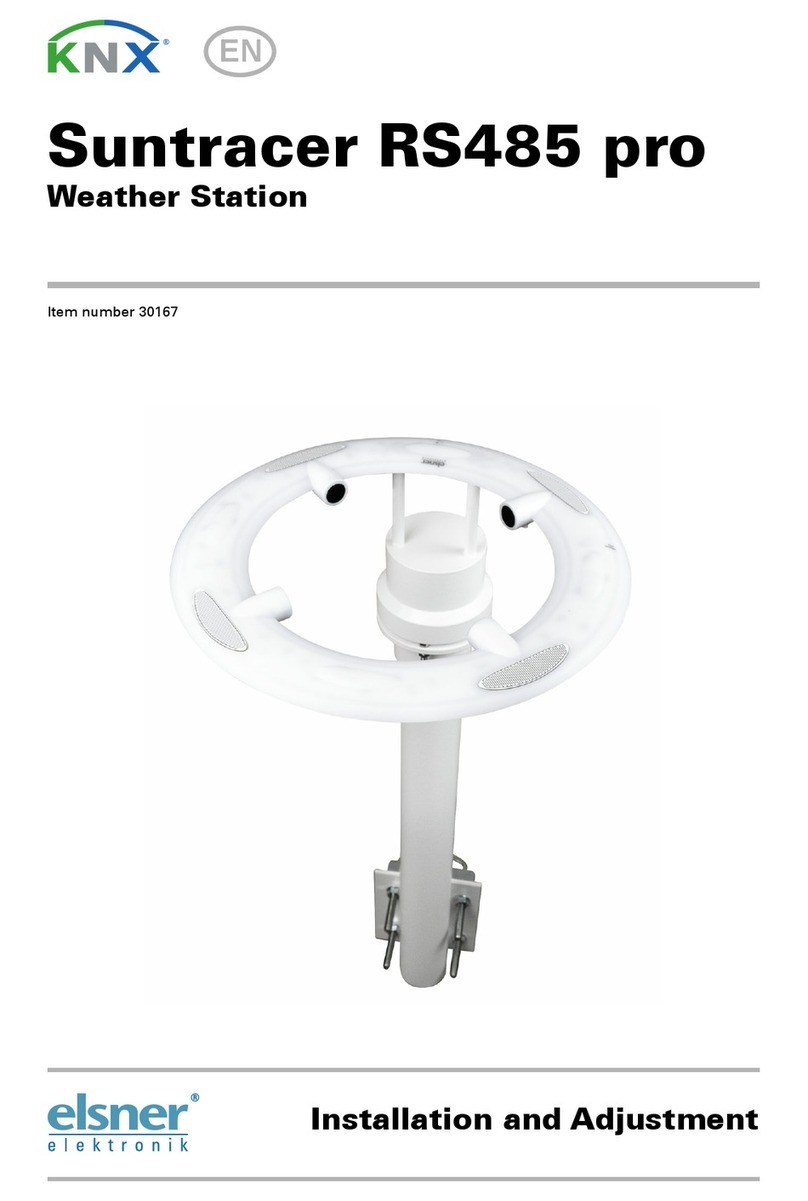
Elsner
Elsner KNX Suntracer pro Guide
